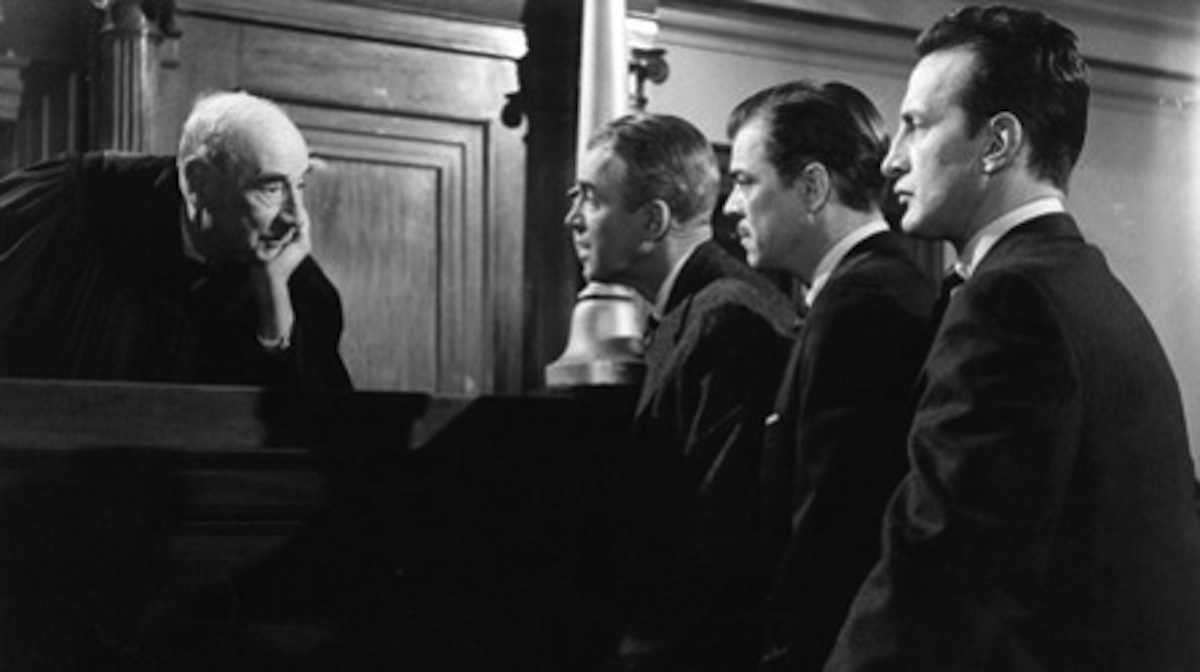Dramatically if not legally, Austrian-born producer-director Otto Preminger was always fascinated with criminal proceedings. Beginning with his tutelage in Vienna under the legendary stage impresario Max Reinhardt, Preminger was drawn to plays that ended with courtroom theatrics. When he shifted to film directing in America he frequently sought out opportunities to stage scenes overseen by judge and jury.
Although Preminger’s fifties work is best remembered for his constant needling of the draconian Production Code, he also used this time to mount three films in which a trial provided the dramatic action: The Court-Martial of Billy Mitchell, Saint Joan and Anatomy of a Murder.
Anatomy of a Murder is a classic courtroom thriller. It poses a legal situation where the accused appears guilty as sin, details the dogged work of a committed defense attorney, and plays out primarily in a courtroom.
It is also based on a true story. In 1951 in Big Bay, Michigan, an army lieutenant, Coleman Peterson, sought out Maurice Chenoweth, a man that Peterson believed had raped his wife. When he found him, the soldier gunned down the presumed rapist. Technically, this would make the killing a premeditated act and therefore murder. The defense attorney, John Voelker (author of the book on which the film is based), used an obscure defense – irresistible impulse – and successfully won the case for Coleman. The movie only changes the names of the characters, and moves the location a few hundred miles.
There are numerous reasons why this story was irresistible to Preminger and why it inspired him to his best work.
For a filmmaker determined to offend the Production Code, Anatomy of a Murder offered him myriad opportunities. The story is centered on an accusation of rape. Although many movies had dealt with this topic in the past (1948’s Johnny Belinda is a prime example), the legal process around it was never openly presented in the movies. Apparently, a rape was acceptable dramatic material, but the legal discussion of it was somehow considered distasteful. Preminger pushed the bounds of the permissible in detailing the accusation in the context of the courtroom. In the process, Anatomy of a Murder features the first use in an American film of the previously forbidden words “panties” and “semen.” A small victory against the Code, but an important symbolic one.
Preminger always saw himself as a showman and had an unerring instinct for devices that would capture the attention of his audience. Beyond needling the Code, he used any opportunity he could to generate a little extra publicity and Anatomy of a Murder is no exception. The cast which features James Stewart, George C. Scott, Lee Remick and Ben Gazzara would have been enough to garner attention, but Preminger puts the pedal to the metal with two surprising additions. In the first, he got jazz great Duke Ellington to not only create the score, but also to play the role of a small town bar pianist. Even more surprising is the judge who presides over the trial. Preminger managed to cast Joseph Welch, the Boston attorney who effectively shut down Joe McCarthy during the Army/McCarthy hearings with the simple but pointed question, “Sir, at long last, have you no sense of decency left?”. Surprisingly, Welch is extremely good, especially when he offers his courtroom the opportunity to laugh at panties and “get it out of (their) system.”
Anatomy of a Murder also allowed Preminger to initiate the next phase in his career. This is the first of his “institutional films.” Over the course of the next six years, Preminger would produce and direct five films that examined the impact of large structures on individuals who live under the guidance/dominance of their restrictions. Taken in toto, Anatomy of a Murder, Exodus (the founding of the state of Israel), Advise and Consent (the US Congress), The Cardinal (the Catholic Church) and In Harm’s Way (the US Navy) represent as sustained a critique of socially-imposed conventions and rituals as any Hollywood filmmaker has ever attempted.
Of course, all of these are just interesting externals to the experience of watching Anatomy of a Murder. If it didn’t deliver the goods then none of this would matter.
Well, it certainly does deliver. Preminger brilliantly manages the frequently botched job of creating an effective balance between legal discussion and dramatics. With half of this movie taking place inside the confines of a small courtroom, Preminger gracefully and subtly guides his camera in and around the action to give us constantly changing perspectives. These movements are matched by our shifting emotions as we try to figure out not what happened, but whether or not it was justified.
Given the cast, performances are uniformly superb, but it should be noted that this is not a star-driven vehicle. Certainly, Stewart is the big name, but he merely plays the central role in a tight ensemble. In this communal environment, the character actors take on more importance and seize the opportunity to give the film some real texture. Particularly noteworthy are the aforementioned Welch, Eve Arden as Stewart’s secretary, Murray Hamilton as a bartender with secrets, and especially Arthur O’Connell as a likable but dissipated lawyer.
Creating a kind of valedictory to his love of the courtroom, Preminger pays close attention to the necessary details of the legal proceedings while measuring these against the the human costs involved in moving justice forward. Best of all, Preminger leaves enough room for a dynamite coda that flings the verdict into ironic relief.
Of course, I won’t give that away. That would be criminal.


